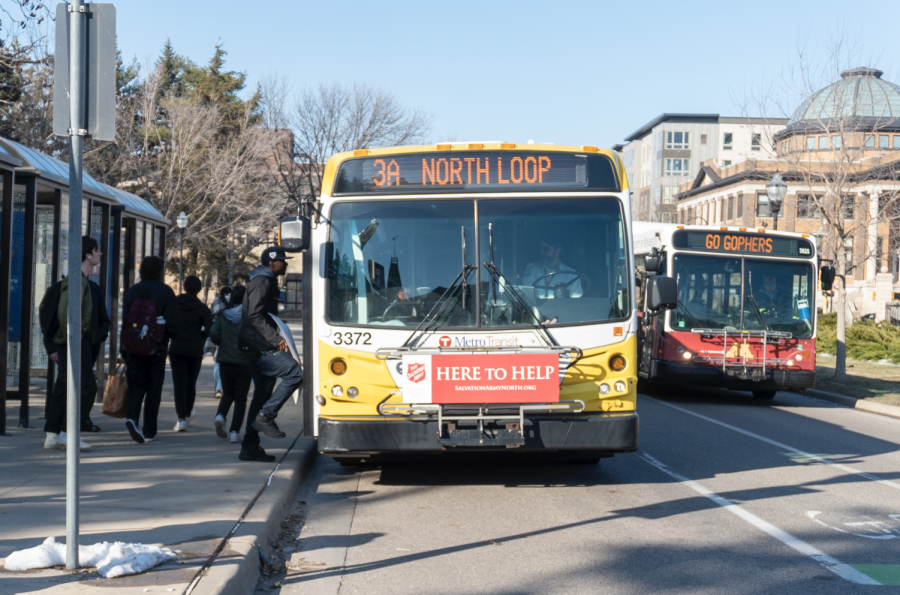In the 2009 State of the County Address on Thursday, Hennepin county board chair and commissioner Mike Opat spoke grimly of the recessionâÄôs effects on the county, sprinkling the speech with praise for the countyâÄôs initiatives. University President Bob Bruininks prefaced the address, which was held in the UniversityâÄôs Carlson School of Management, by noting that about 100,000 of Hennepin CountyâÄôs residents graduated from the University of Minnesota. âÄúI think the future of Hennepin County and the future of the University are really closely connected,âÄù Bruininks said.
Troubled waters
Opat wasnâÄôt shy in listing the difficulties facing the county. Initial forecasts cut as much as $100 million from the 2010 budget, and $20 million has already been slashed by from the budget this year, he said. Unemployment is at a higher rate in Hennepin County than the rest of the state, currently at 47,000 people, or 7.5 percent âÄîa sharp rise from 1.9 percent ten years ago. The largest portion of the countyâÄôs budget, 31 percent, goes toward providing a âÄúsafety netâÄù for the elderly, disabled, low-income individuals, veterans and children through programs such as medical assistance and unemployment assistance, among other things. Dan Engstrom, director of the countyâÄôs Human Services and Public Health Department , oversees these services. As the county loses state and federal funding, it becomes more difficult for the county to provide the necessary services, he said. âÄúWe must be the faces and the voices of our most vulnerable people âÄî the poor, the sick, the developmentally disabled, the blind, deaf and hard-of-hearing âÄî all deal directly with the county,âÄù Opat said. The federal stimulus dollars will help temporarily, but wonâÄôt be enough, Engstrom said. âÄúItâÄôs really a one-time fix,âÄù he said. âÄúItâÄôs not a permanent solution.âÄù Foreclosure rates have increased six-fold since 2004, from about 1,200 to over 7,000 last year, Opat said, adding that this poses a major problem for a unit of government primarily dependent upon property taxes. About 37 percent of the countyâÄôs budget comes from property taxes. In the countyâÄôs 4th District, which includes the University of Minnesota, the biggest issues have been developing the light-rail transit system in the metropolitan area, commissioner Peter McLaughlin said. The county is facing incredible pressure to continue to provide the same services using less money from the federal and state governments, he said. âÄúWeâÄôre in a heck of trouble here,âÄù he said.
Not all bad news
It wasnâÄôt all doom and gloom. Opat detailed a number of positive steps the county is taking to address major issues. For decades, the Hennepin County Board of Directors doubled as the Hennepin County Medical Center Board. A couple years ago, however, they managed to pass a state law to create the Hennepin Healthcare System Board , comprised of health care experts. Since then, Opat said, the HCMC has been able to make more informed purchasing and managerial decisions. In 2008, the consolidation of the Hennepin and Minneapolis library systems paved the way for more efficiency, Opat said. The county has since opened three formerly closed Minneapolis libraries. Transit received extensive mention in the address. Opat praised the county for its leadership in building the Hiawatha Light Rail corridor. Hennepin County joined four other counties in the metro area last May to create the Counties Transit Improvement Board , dedicated to expanding the transit networks in the metro area. The CTIB will oversee construction of the Central Corridor LRT Line , which will run from Minneapolis to downtown St. Paul. Later this year, the Northstar Commuter Rail will run from Minneapolis to Big Lake. The county will see the addition of two more Light Rail corridors, whose locations will be announced by the end of the year, Opat said. Target Field in downtown Minneapolis, open to the public in less than a year, employed over 3,100 people throughout its construction, Opat said. The field will be one of the countryâÄôs few LEED-certified or âÄúgreenâÄù ballparks. To address the chronic homelessness, in 2006 county officials created Heading Home Hennepin , a ten-year plan to end homelessness, with several partners involved. In 2007 the county joined the Cool Counties Initiative , a nationwide climate change prevention program, and has set a goal to reduce greenhouse gas emissions by 80 percent in 2050. Hennepin County âÄî home to about 22 percent of the stateâÄôs population âÄî is the largest of MinnesotaâÄôs 87 counties. It is governed by a seven-member board of commissioners; each elected to serve staggered four-year terms. In the end of his address, Opat emphasized perseverance and a strong adherence to the mission of the county: to enhance residentsâÄô health, safety and quality of life. He called the county âÄúchallenged, but not imperiled.âÄù
















